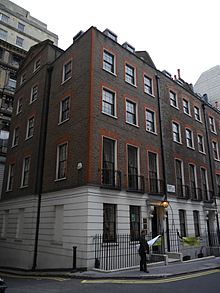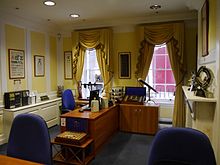College of Optometrists


The College of Optometrists is the professional, scientific and examining body for optometry in the United Kingdom, working for the public benefit. Their headquarters is at 41-42 Craven Street, London WC2, of which no 41 is a Grade II listed building.[1]
History
After the founding of the British Optical Association (BOA) in 1895, several more professional bodies were formed for the development of British optometry and by 1958 only four were in evidence authorised to conduct examinations and award professional qualifications statutorily approved by the General Optical Council. In 1962 the Institute of Optical Science (tracing its history to 1905) merged with the BOA thus leaving only three approved professional organisations for British optometry. The creation of a new professional body in the form of a Royal College for optometrists was suggested in 1972 in a letter published by Rishi Agarwal.[2][3][4][5]
The College was established in 1980 by three separate bodies, the former British Optical Association founded in 1895 and the Scottish Association of Opticians tracing its history to 1903 (both of which were disbanded in 1980) and the Worshipful Company of Spectacle Makers (incorporated by a Royal Charter in 1629 during the reign of King Charles I) which surrendered its examining function to the new College. In 1980 the title British College of Ophthalmic Opticians (Optometrists) was adopted. In 1987 the title was changed to British College of Optometrists and in 1995 the title College of Optometrists was adopted.
Royal charter
The College of Optometrists was granted a royal charter by Queen Elizabeth II on 18 September 1995.[6][7] This was celebrated at Guildhall on 25 January 1996 and attended by HRH the Duchess of Gloucester and members of the college and guests.[8]
Location
Shortly before its formal foundation, the College was based at 10 Knaresborough Place in Earls Court, London. The College moved to its current headquarters in Craven Street in 1997.
Secretariat
The College also provides the accommodation and Secretariat for the World Council of Optometry[9] (WCO) and the European Academy of Optometry and Optics[10] (EAOO).
References
- ^ Historic England. "41 Craven Street WC2 (1220948)". National Heritage List for England. Retrieved 18 September 2016.
- ^ Agarwal, R. (1972), Some challenging thoughts, Optician, 27 October, page 32.
- ^ Schoen, John N.(1981), Secretary's Page, American Journal of Optometry and Physiological Optics, Volume 58, Number 7, pp 594-595, published by the American Academy of Optometry.
- ^ Cole, John (1981), The voice of optics, Optician, volume 181, number 4680, page 27.
- ^ Mullins, P. (1983), The Editor's Round, The way we thought 10 years ago, Optician, volume 185, number 4795, page 6.
- ^ Agarwal, R. (1995), A Royal Charter for Optometrists, British Journal of Optometry and Dispensing, Volume 3, Number 3, page 100.
- ^ Agarwal, R. (2011), A Royal College for Optometrists, Optician, volume 241, number 6294, page 11.
- ^ Lynch, M. and Cole, P. (1999), The College of Optometrists, A History 1980-1998, published by The College of Optometrists, page 229.
- ^ World Council of Optometry.
- ^ European Academy of Optometry and Optics.
External links
- College of Optometrists website
- British Optical Association Museum
 Media related to College of Optometrists at Wikimedia Commons
Media related to College of Optometrists at Wikimedia Commons
51°30′28″N 0°07′32″W / 51.507865°N 0.125428°W
- Use dmy dates from September 2012
- Eye care in the United Kingdom
- Professional associations based in the United Kingdom
- Organizations established in 1980
- Organisations based in London with royal patronage
- 1980 establishments in the United Kingdom
- Worshipful Company of Spectacle Makers
- Grade II listed buildings in the City of Westminster
